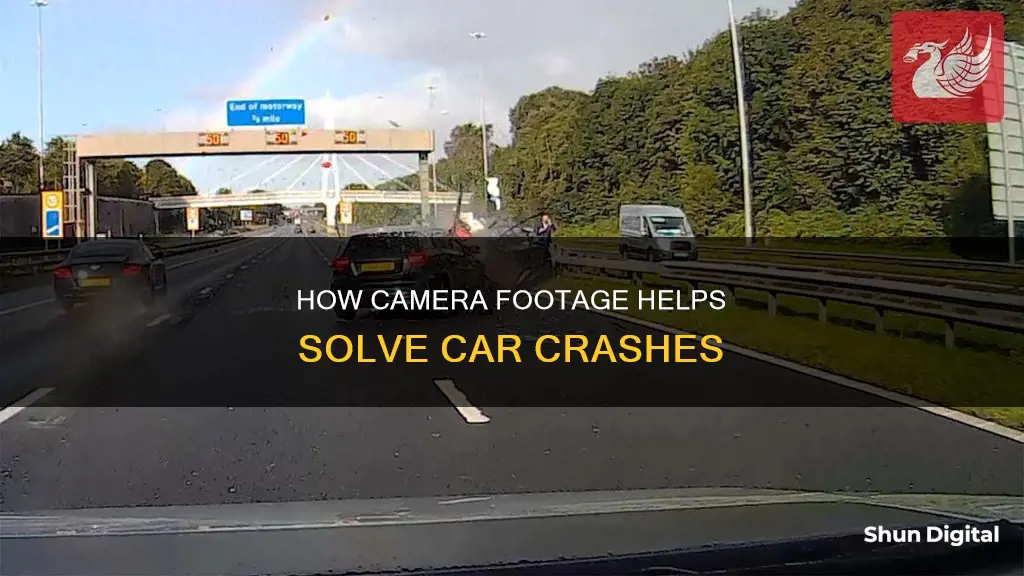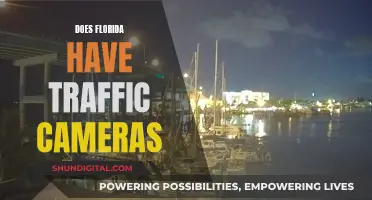
Car crashes are a common occurrence on modern roads, and the ability to access camera footage of these incidents can be crucial in determining the cause of the accident, holding responsible parties accountable, and providing evidence for insurance claims and legal proceedings. Camera footage of a car crash can come from various sources, including traffic cameras, dashcams, property surveillance cameras, social media, news traffic cameras, and police body cameras. Obtaining this footage can often be a complex and time-consuming process, involving identifying the camera's location and jurisdiction, contacting the appropriate agency, and making formal requests. In some cases, legal assistance may be required to access certain types of camera footage.
| Characteristics | Values |
|---|---|
| Purpose of camera footage | Evidence for insurance claims and lawsuits, and to determine the cause of the accident and hold responsible parties accountable |
| Types of cameras | Highway, traffic, or intersection cameras; dashcams; property surveillance cameras; social media footage; stationary news traffic cameras; police bodycams |
| Process of obtaining footage | Identify camera location and jurisdiction; contact the appropriate agency; request the footage; review the footage; seek legal advice if needed |
| Storage of footage | The length of time traffic cameras keep footage varies, from a few days to several weeks or months, and in some cases, even years |
What You'll Learn
- Traffic camera footage can be used as evidence to determine the cause of an accident
- Obtaining footage can be complex and time-consuming
- Footage can be obtained from dashcams, property surveillance cameras, social media, and news traffic cameras
- The footage can be crucial in holding responsible parties accountable and proving negligence
- It is important to act quickly as footage may be deleted or overwritten after a short period

Traffic camera footage can be used as evidence to determine the cause of an accident
Traffic camera footage can be used as powerful evidence to determine the cause of a car accident and to establish liability. This is because it provides an objective, neutral, and potentially definitive view of what happened. It can also help verify the accounts of those involved in the accident and strengthen their credibility. In addition, accident reconstruction experts can use the footage to determine factors such as the speed of the vehicles, the sequence of events, and the point of impact.
However, obtaining traffic camera footage can be a complex and meticulous process. The first step is to identify the location and jurisdiction of the camera. This can be done by reviewing the police report or contacting the local police department or department of transportation. Once the camera's jurisdiction is known, the appropriate agency must be contacted to request the footage. This may involve contacting a government agency or a private company, depending on who operates the camera. It is important to provide details such as the date, time, and location of the accident when requesting the footage. In some cases, a release form or fee may be required to obtain the footage.
It is crucial to act quickly when requesting traffic camera footage, as it is often only stored for a short period, from a few days to several weeks or months. Without swift action, the footage may be recorded over or deleted and become permanently unavailable. Therefore, those involved in an accident or their legal representatives should make their request as soon as possible.
In some cases, privately owned camera footage, such as from businesses' surveillance cameras or individuals' dashcams or cell phones, may also be relevant to an accident. Obtaining this footage can be more challenging and may require legal processes if the owner is unwilling to cooperate. An experienced car accident lawyer can be invaluable in obtaining and leveraging all available camera footage to build a solid case and ensure fair compensation for their client.
The First Camera: A Historical Perspective
You may want to see also

Obtaining footage can be complex and time-consuming
Obtaining footage of a car crash can be a complex and time-consuming process. The first step is to identify the location and jurisdiction of the camera. This can involve reviewing the police report or contacting the local police department or department of transportation. Once the camera's location and jurisdiction have been identified, the next step is to contact the appropriate agency to request the footage. This may be the local police department, the department of transportation, or a private company.
When requesting the footage, it is important to provide as many details as possible about the accident, including the date, time, and location. It is also important to be persistent but polite in following up on the request. In some cases, a release form or fee may be required to obtain the footage.
If the crash occurred on private property, such as a store or business premises, obtaining the footage can be even more challenging. In these cases, the video footage is considered private, and the property owner is not legally obligated to make it available. While it is possible to speak to the property owner and request the footage, they may refuse or be uncooperative. In these instances, the footage would need to be subpoenaed in court.
To increase the chances of obtaining the footage, it is crucial to act quickly. Many agencies and businesses only retain video footage for a short period, with some keeping records for just a day or two. Therefore, any delay in requesting the footage may result in it being overwritten or deleted.
Given the complexity and urgency of obtaining car crash footage, it is often advisable to seek legal assistance. An experienced attorney can help navigate the process, determine the appropriate channels for requesting footage, and ensure that evidence is preserved. They can also provide guidance on using the footage effectively to support any legal claims or proceedings that may arise from the accident.
Huawei's Surveillance Camera Lineup: An Overview
You may want to see also

Footage can be obtained from dashcams, property surveillance cameras, social media, and news traffic cameras
Car accidents can be traumatic and devastating for those involved and their families. In the aftermath, it is crucial to determine the cause of the accident and hold the responsible party accountable. Obtaining camera footage of the incident can be instrumental in achieving this.
Footage can be obtained from various sources, each presenting its own set of challenges. Here are the key ways to access video evidence:
Dashcams
More and more drivers are using dashcams to record their journeys. This footage can be invaluable in determining the circumstances of an accident, but finding the owner of the dashcam footage can be like searching for a needle in a haystack. It requires identifying the exact time and location of the accident and then tracking down any dashcam owners in the vicinity.
Property Surveillance Cameras
Surveillance cameras mounted on private properties, such as residences, businesses, or event spaces, can also capture car accidents. However, obtaining footage from these sources can be tricky. The person using the property may not be the owner and may not have the authority to provide video footage. It is essential to identify the property owner and make a formal request for the footage.
Social Media
In today's world, it is common for bystanders to record accidents on their phones and upload them to social media platforms like YouTube, TikTok, Twitter, or Facebook. This footage is usually easy to obtain and download if you can find it. Scouring social media platforms for any videos related to the accident can be a helpful way to gather evidence.
News Traffic Cameras
Some TV news organizations install 24-hour cameras at significant traffic locations. This footage is sometimes available online, but if not, a request can be made to the news organization for the relevant clips. These cameras are often stationary and focused on areas with high traffic, so they may capture crucial evidence.
Obtaining footage from any of these sources can be a complex and time-consuming process. It may involve identifying owners, making formal requests, and even taking legal action to preserve the footage before it is overwritten or deleted. However, the effort is often worth it, as video evidence can be critical in determining fault, understanding the severity of the incident, and ensuring a successful insurance claim or legal case.
Surveillance Cameras: Security, Safety, and Peace of Mind
You may want to see also

The footage can be crucial in holding responsible parties accountable and proving negligence
Camera footage of a car accident can be critical evidence in a claim. It can be used to prove negligence and hold responsible parties accountable.
Negligence is a legal theory that must be proven before holding someone responsible for harm suffered. It is a failure to behave reasonably to prevent foreseeable harm to possible victims. In the context of a car accident, negligence can include a driver texting and ignoring the road, failing to adhere to traffic laws, driving recklessly, or engaging in distracted driving behaviours.
To win a negligence case and hold the responsible party accountable, the plaintiff must prove four elements: duty, breach, causation, and damages. Duty refers to the legal responsibility of the defendant to the plaintiff, such as the responsibility of drivers to operate their vehicles safely. Breach occurs when the defendant fails to uphold this duty, such as by driving recklessly. Causation establishes that the defendant's negligence caused the plaintiff's injury. Finally, damages refer to the harm or injury suffered by the plaintiff as a result of the defendant's actions.
Camera footage can provide crucial evidence to support these elements of a negligence claim. For example, footage from highway, traffic, or intersection cameras; dashcams; property surveillance cameras; or even social media posts can capture the events leading up to and during a car accident. This footage can help establish duty, show a breach of duty, prove causation, and document the damages or harm caused.
Additionally, police bodycam footage may capture important details in the aftermath of an accident, such as vehicle positions or the behaviour of the drivers involved. Police reports, which may include the responding officer's opinion on who was at fault, are also key pieces of evidence for establishing negligence.
Obtaining camera footage of a car accident can be a complex and time-consuming process, as it involves identifying the owner of the footage and requesting a copy. However, with the help of a skilled attorney, individuals can take the necessary steps to preserve and obtain this crucial evidence to support their claim and hold the responsible party accountable for their negligence.
The Magic Behind Auto-Focus Cameras
You may want to see also

It is important to act quickly as footage may be deleted or overwritten after a short period
Car accidents can be devastating for those involved and their families. In the aftermath, it is crucial to determine the cause of the accident and hold the responsible party accountable. One of the most important pieces of evidence in a car accident case is footage of the incident. This can come from a variety of sources, including dashcams, property surveillance cameras, social media, and traffic cameras. However, obtaining this footage can be a complex and time-consuming task, and it is important to act quickly as footage may be deleted or overwritten after a short period.
The length of time that camera recordings of a crash are available varies. Some businesses and government agencies have policies in place to retain footage for a set period, which could range from a few days to several weeks or even months. In contrast, footage from personal dashcams, cellphones, or surveillance cameras can be deleted at any time, and individuals may record over old footage or delete videos to free up space. Therefore, it is crucial to act promptly to increase the chances of obtaining the necessary footage.
To improve your odds of obtaining camera footage of a car accident, there are several steps you can take. First, identify the location and jurisdiction of the camera. This information can be found in the police report or by contacting the local police department or department of transportation. Once you have identified the agency responsible for the camera, reach out to their representatives to request access to the footage. Be prepared to provide details such as the date, time, and location of the accident. It is important to be persistent yet polite in your follow-up calls or emails.
In some cases, you may need to fill out a privacy release form and assure the agency that you will only use the footage for personal purposes. Additionally, some agencies may charge a fee for providing the footage, so be sure to inquire about any potential costs before finalizing your request. Don't forget to follow up on your requests periodically to ensure they don't fall through the cracks.
While requesting camera footage may seem straightforward, it often involves a lot of patience, paperwork, and follow-up. Even if you provide all the necessary details, there is no guarantee that you will receive the footage you need. Therefore, it is essential to act quickly and take the necessary steps to improve your chances of obtaining this valuable evidence.
Updating Camera Raw in Lightroom: Offline Method
You may want to see also







